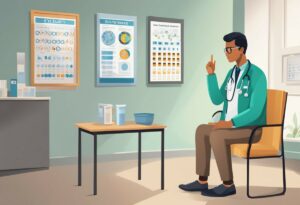Safeguarding Vision: The Critical Importance of Eye Safety in the Workplace


Young serious male engineer or factory worker in protective helmet and eyeglasses standing in front of camera in workshop environment
Ensuring the safety of one’s vision in the workplace is not only a matter of personal health but also an organizational imperative. At New England Low Vision and Blindness, we understand the significance of protecting employees’ eyesight. As a leading provider of assistive technology and training for those with visual impairments, we recognize March as Workplace Eye Wellness Month—a time to emphasize the importance of eye safety. Statistics show that thousands of workers suffer from job-related eye injuries each year, leading to not only pain and suffering but also to significant economic costs due to medical expenses and productivity losses.
To foster a culture of safety that protects our most valuable sensory organ, it is crucial for employers to identify and mitigate workplace hazards. Proactive measures include regular eye safety training, provision of appropriate protective eyewear, and keeping up-to-date with leading-edge solutions for vision health. Such steps are essential in preventing accidents and preserving the vision of employees, which is paramount to maintaining efficiency and a high quality of life.
Understanding Workplace Eye Hazards
Eye safety in the workplace is crucial, as various hazards pose risks to workers’ vision. Injuries can occur from avoidable accidents, often leading to significant health impacts and financial costs.
Types of Eye Hazards
There are numerous potential eye hazards in work environments, with varying impact potential. Some of the primary types include:
- Dust and small particles: These can cause irritation and abrasions if they come into contact with the eye.
- Chemical splashes: Hazardous chemicals can burn or severely damage eye tissue upon contact.
- Flying debris: Chunks of material expelled by machinery can cause penetration injuries or blunt trauma to the eye.
- Sharp objects: Tools and equipment can scratch or pierce the eye, leading to serious injuries.
Common Causes of Eye Injuries
Eye injuries are often the result of not wearing proper protection or being in the vicinity of:
- Inadequate safety measures: Lapses in protocols can expose workers to hazards.
- Lack of awareness: Workers unaware of potential risks may not take necessary precautions.
- Mechanical risks: Operations involving cutting, drilling, or sanding materials without appropriate guards or safety gear.
It is essential to assess work conditions and implement leading-edge safety strategies to minimize these risks.
Impact of Eye Injuries on U.S. Workers
Every day, approximately 2,000 U.S. workers sustain occupational eye injuries that warrant medical treatment. The implications of these injuries are far-reaching, including:
- Personal suffering: from the pain and possible permanent vision impairment.
- Economic costs: due to medical expenses and lost productivity.
Protecting the vision of workers is not only a health imperative but also an economic necessity. As a leading assistive technology provider, we focus on equipping individuals and workplaces with resources to enhance safety and aid those affected by visual impairments. During Workplace Eye Wellness Month, our mission grows stronger as we emphasize the importance of recognizing and guarding against workplace eye hazards.
Eye Safety Measures and Protective Equipment
We recognize the critical importance of eye safety in the workplace, especially during March Awareness Month: Workplace Eye Wellness. Within this section, we discuss the types of eye protection available, criteria for selecting the right safety eyewear, and the standards and regulations that govern eye safety gear.
Types of Eye Protection
Protective eyewear is essential for safeguarding vision against hazards that can cause injury. There are various types of eye protection employed in different environments, and choosing the right one is paramount:
- Safety Glasses: These are primarily used for protection against impact from small particles or objects. They feature side shields and are recommended for general use in areas where eye hazards are present.
- Goggles: Offering a secure fit and shielding the eyes from all angles, goggles provide a higher level of protection from dust, splashes, or airborne particles.
- Face Shields: For activities that expose workers to higher risks, such as chemical splashes or welding, face shields offer full-face protection and should be used in conjunction with safety glasses or goggles.
Selection Criteria for Safety Eyewear
When selecting safety eyewear, it’s imperative to consider the following aspects to ensure optimal protection:
- Fit: The eyewear must provide a comfortable, secure fit without impeding the user’s ability to work.
- Material: Durable materials like polycarbonate are ideal for lens construction, providing high-impact resistance.
- Lens Coating: Anti-fog and scratch-resistant coatings extend the usability and life of the eyewear.
Standards and Regulations for Eye Safety Gear
Adherence to standards and regulations is necessary to guarantee the effectiveness of eye safety gear:
- Organizations such as the American National Standards Institute (ANSI) set forth criteria that safety eyewear must meet, designated as ANSI Z87.1.
- Employers are responsible for ensuring that employees use eye protection compliant with these standards when exposed to workplace eye hazards.
By equipping our workforce with leading-edge personal protective equipment (PPE) and ensuring compliance with safety regulations, we contribute to a culture of wellness and prevention during Workplace Eye Wellness Awareness Month and beyond. Safe practices, coupled with the right protective equipment, are the cornerstone of maintaining visual health in any occupational setting.
Preventative Strategies and Best Practices
Ensuring the safety and health of employees’ eyesight in the workplace involves a multi-faceted approach. Our comprehensive strategy focuses on the implementation of safety policies, consistent training and awareness programs, and the encouragement of regular eye tests and exams to maintain optimal vision health.
Implementing Eye Safety Policy
At New England Low Vision and Blindness, we understand that an effective eye safety policy is the cornerstone of preventing workplace-related eye injuries. OSHA guidelines serve as a foundation for our policies, which are tailored to meet the specific needs of various work environments. Employees are required to use personal protective eyewear, such as goggles or face shields, in accordance to the job hazards they may encounter. This is part of our suite of safety measures designed to protect against physical, chemical, and radiological dangers that can compromise vision.
Training and Awareness
We emphasize the importance of training and awareness programs that teach employees how to recognize potential hazards and the proper use of eye protection. As part of these programs, we advocate for the 20-20-20 rule to reduce eye strain, especially for those working on computers or devices for prolonged periods. By looking 20 feet away, for 20 seconds, every 20 minutes, employees can minimize the strain on their eyes and maintain better eye health.
Regular Eye Tests and Exams
Encouraging regular eye exams is another key aspect of our approach. We urge our employees to have their vision tested regularly to detect any changes as early as possible. This practice not only safeguards against the progression of eye-related issues but also ensures that any prescription eyewear is current and effective. Such preventative measures can significantly reduce the risk of workplace eye injuries and sustain overall eye wellness.
By adopting these preventative strategies and best practices during March Awareness Month and beyond, we aim to maintain a safe and healthy workplace where vision welfare is prioritized.
Emergency Response and Treatment for Eye Injuries
In promoting workplace eye wellness, it’s crucial to be prepared for potential eye injuries. Having the right response and treatment protocols in place can mean the difference between quick recovery and lasting damage.
First Aid for Eye Injuries
When an eye injury occurs, immediate and appropriate first aid is essential before professional medical treatment is sought. For minor injuries like small debris in the eye, encourage the affected person to blink several times and then clean the eye with a stream of saline or clean water. For more serious injuries, such as cuts or punctures, avoid washing out the eye and instead cover it with a rigid shield without exerting pressure on the eye itself.
Emergency Eye Equipment on Site
Every workplace should have emergency eye wash stations readily accessible. These stations provide immediate decontamination, flushing out hazardous substances that might come into contact with the eyes. It’s imperative to use the eye wash station immediately after exposure to chemicals or irritants. We consider these stations to be an essential aspect of leading-edge safety equipment.
Professional Medical Treatment
For all eye injuries, after initial first aid, it’s critical to seek professional medical treatment without delay. Ensure swift transport to emergency departments or eye trauma centers. An examination by an eye care professional can assess the extent of the damage and set the course for necessary treatment. Remember, preserving vision and eye health is a priority and getting expert care is a key component of that commitment.
During March Awareness Month, we, New England Low Vision and Blindness, stress the importance of emergency preparedness as part of workplace eye wellness. We take pride in bringing hope and providing life-changing resources to those impacted by visual impairment.
Promoting a Culture of Eye Safety in Work Environments
Creating a vigilant approach to eye safety is essential in minimizing vision loss and preventing work-related eye injuries. By engaging every level of an organization, a culture of safety becomes the norm, not the exception.
Management’s Role in Eye Safety
Leadership commitment is paramount when it comes to establishing and sustaining a culture of workplace eye safety. We advocate for managers to actively promote eye wellness, ensuring that policies not only comply with regulations but also go beyond them to offer leading-edge protection. This includes providing comprehensive eye safety training and ensuring all employees have access to appropriate personal protective eyewear.
Management should also:
- Regularly review and update eye safety protocols.
- Offer vision screenings as part of routine health assessments.
- Lead by example, wearing protective eyewear when necessary.
Employee Engagement and Responsibility
Every individual in the workplace has a role to play in maintaining their own eye health. Employees are encouraged to be proactive by participating in safety training sessions and adhering to established protocols.
Employees can actively engage by:
- Utilizing protective eyewear correctly.
- Following the 20-20-20 rule to reduce eye strain.
- Reporting hazards that could lead to eye injuries.
Audit and Continual Improvement
Continuous improvement is vital for an enduring eye safety culture. Audits help identify areas of improvement and shed light on emerging risks in the workplace. By staying up-to-date with the latest advancements in eye safety and assistive technology, organizations can ensure they are providing the best possible protection against work-related eye injuries.
Our approaches include:
- Conducting regular eye safety audits and risk assessments.
- Implementing changes based on audit findings.
- Investing in new technologies and training to enhance vision wellness.
As we recognize March Awareness Month: Workplace Eye Wellness, we emphasize the importance of protecting each other’s sight. Our dedication during this month and throughout the year is to equip workplaces with resources to preserve and enhance the vision of their teams.






